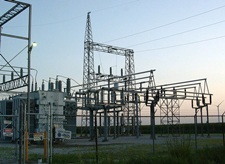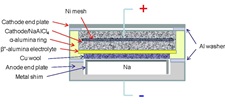Flat sodium-nickel chloride battery could improve performance, cost of energy storage
12 Oct 2010
A redesign of sodium-nickel chloride batteries promises to overcome some of the obstacles long associated with rechargeable batteries.
 Replacing their typical cylindrical shape with a flat disc design allows the battery to deliver 30-per cent more power at lower temperatures, according to work published by the Department of Energy's Pacific Northwest National Laboratory in the October 8 issue of ECS Transactions, a trade journal. Researchers say these sodium-beta batteries could eventually be used in electricity substations to balance the generation and delivery of wind and solar power on to the grid.
Replacing their typical cylindrical shape with a flat disc design allows the battery to deliver 30-per cent more power at lower temperatures, according to work published by the Department of Energy's Pacific Northwest National Laboratory in the October 8 issue of ECS Transactions, a trade journal. Researchers say these sodium-beta batteries could eventually be used in electricity substations to balance the generation and delivery of wind and solar power on to the grid.
 Because the battery's main components include abundant materials such as alumina, sodium chloride and nickel, they are less expensive to manufacture than lithium-ion batteries, and could still offer the performance necessary to compete for consumers' interest. In addition, compared to other battery systems, sodium-beta batteries are safer and can help incorporate renewable energy sources into the electrical system easier.
Because the battery's main components include abundant materials such as alumina, sodium chloride and nickel, they are less expensive to manufacture than lithium-ion batteries, and could still offer the performance necessary to compete for consumers' interest. In addition, compared to other battery systems, sodium-beta batteries are safer and can help incorporate renewable energy sources into the electrical system easier.
"This planar sodium battery technology shows potential as an option for integrating more solar and wind power into our electric grid," said Carl Imhoff, electricity infrastructure sector manager at PNNL.
Sodium-beta alumina batteries have been around since the 1960s but their tubular, cylindrical shape does not allow efficient discharge of stored electrochemical energy. This inefficiency causes technical issues associated with operating at high temperatures and raises concern about the cost-effectiveness of the tubular batteries.
Lithium-ion batteries surpassed sodium-beta batteries because they perform better. However, materials for lithium batteries are limited, making them more expensive to produce. Safety also has been a concern for rechargeable lithium batteries because they can be prone to thermal runaway, a condition where the battery continually heats up until it catches fire.













.jpg)






.jpg)









